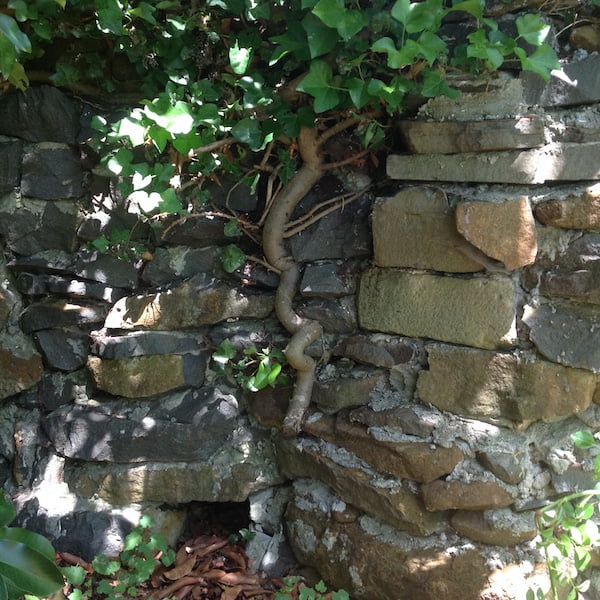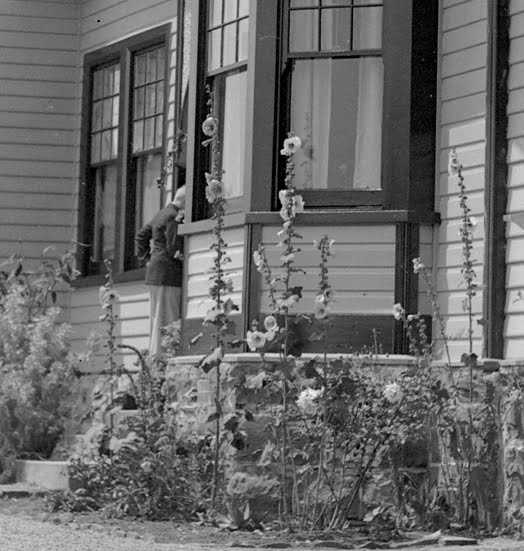Gardening is touted as good for your health and mind but it is also a pathway to discover more about history and the world around us. It is even possible to learn about Australian politics through gardening.

A view of Home Hill when it was built in 1916 for the newly wed Joe and Enid Lyons. It was extended and altered to meet the needs of their growing family. Photo: Collection Home Hill, National Trust of Australia (Tasmania)
I am the first to admit that my knowledge of Australian Prime Ministers and politics is a little shaky but a Tasmanian garden has led me to learn a lot more about Joseph Lyons (Prime Minister from 1932-1939 and before that Tasmanian Premier from 1923-1928), his politician wife, Dame Enid Lyons and their large family.

Joe Lyons, Australia’s 10th Prime Minister, died in office in 1939. He is shown here with his wife Enid (later Dame Enid) and 11 surviving children on the front steps of Home Hill in Devonport, Tasmania in 1936. Photo: Collection Home Hill, National Trust of Australia (Tasmania)
Dame Enid was a keen gardener and homemaker as well as Australia’s first female member of parliament. She went to Canberra as a Member of the House of Representatives in 1943 after Joe’s untimely death in office in 1939. She served until 1951 and was also the first woman appointed to Federal Cabinet.

Dame Enid seated in her boldly papered living room looking out into the garden, c. 1970s. She decorated the house herself and filled it with flowers picked from her garden. Photo: Collection Home Hill, National Trust of Australia (Tasmania)
History books and even films reveal much about the past, but stepping into it is a far more interesting and more lasting way to learn. Before her death in 1981, Dame Enid made sure that the Lyons’ family home, Home Hill at Devonport (77 Middle Road, Miandetta) in Tasmania, was left to the Australian people complete with its information-packed interior and her lovingly built and tended garden.

Dame Enid wrote in a newspaper article: “there is no house that can’t be improved with white paint and a bougainvillea”. The scarlet bougainvillea continues to thrive at Home Hill. The house was originally a dark colour but later painted white. Photo: Jennifer Stackhouse
If you’ve not visited this historic property with its simple white-painted 1916 house, put it firmly on the must-do list. The property is owned and managed by Devonport City Council but the National Trust of Australia (Tasmania) administers the house interior with its Lyons’ furnishings, ornaments and memorabilia. Visit for a guided tour at 2pm Wednesday to Sunday from September to June (see nationaltrust.org.au for more details).
Although now separated from the town of Devonport by the busy Bass Highway, the property retains some of its original 3.6-hectare (nine-acre) grounds that once included an orchard, which the practical Joe and Enid Lyons saw as a potential income if Joe’s political career failed.

Enid’s grandsons Chris and Tony on the lawn in front of Home Hill in the 1950s. Dame Enid terraced the rocky slope with low stonewalls to make raised flowerbeds around the house. Photo: Collection Home Hill, National Trust of Australia (Tasmania)
The garden on a rocky north-facing hillside was planted by Dame Enid and at its peak from the 1950s to the 1970s. Dame Enid delighted in dry stonewalls, self-seeding cottage plants such as hollyhocks, and flowering shrubs such as camellias and rhododendrons. She also grew maples and planted lots of conifers including cypress and pines around the house. She even grew a macadamia.

Dame Enid Lyons beside the pond she dug, paved and planted in her garden at Home Hill, Devonport (circa 1970s). Photo: Collection Home Hill, National Trust of Australia (Tasmania)
For Dame Enid her garden’s crowning feature was the pond she dug and surrounded with paving and colourful plantings.

A cluster of Pink Pearl rhododendrons in bloom, Joe Lyons’ favourite flower. It grew in the garden. Photo: Adobe Photo Stock
Homemaker and gardener
As a mother of 12 children (one of whom died in infancy), widowed young and facing huge financial worries and health issues, Home Hill and its garden was a sanctuary for Dame Enid. Writing about her life she admits to collapsing after her beloved Joe’s death and needing time and the calm surroundings of her home and garden to get her back on her feet.
Recent Prime Minister’s wives have decorated and redecorated The Lodge, the Prime Minister’s Canberra residence, but Dame Enid turned her attention to her own home. As well as planting and building a garden, she also wallpapered, upholstered, painted and made changes to the layout of the house. Magazine and newspaper articles often inspired her handiwork in the house and out in the garden.
One of Dame Enid Lyons’ favourite rooms at Home Hill at Devonport was the Blue Room, part of the living room, opens on to a small garden courtyard once planted with blue-flowered plants including hydrangeas, rhododendrons and grape hyacinths. There are memorials here for Joe Lyons and also for one of her children, Brendan and her grandson Joseph.
At one of edge of this garden is a towering sequoia (Sequoia sempervirens) grown from seed gathered during the Lyons’ visit to the US in 1937 after they attended the coronation of George VI in England. It is planted beside memorials to Joe Lyons. Joe died in April 1939 and for me this tree is a living memorial of the man himself.
Management plan underway

Dame Enid built several stonewalls in the garden along with stone retaining walls (above) for garden beds, but this one has not stood the test of time. Photo: Jennifer Stackhouse

Detail of a stone retaining wall built by Dame Enid. Photo: Jennifer Stackhouse
While the bones of the garden remain, Dame Enid’s landscaping work has not stood the test of time and most of her cottage garden planting has long gone. All that’s set to change thanks to a grant from the Australian Garden History Society that has funded a Landscape Management Plan to chart a course for the restoration and management of the garden at Home Hill.
The plan will bring together the history of the site, photographic records including a series of aerial views dating from 1946, its living heritage and recommend how to best preserve and present Dame Enid’s treasured garden and landscaping features.
As well as being inspired in her gardening and decorating by ideas from magazines, Dame Enid also inspired others with her own radio broadcasts on the Macquarie Network where she discussed her domestic passions including her garden.
According to Ann Teesdale, the National Trust’s Property Manager at Home Hill, one of her most popular broadcasts was about blue flowers:
“Outside the French doors of our living room, there is a little separate garden that is really an outdoor room. It has a lovely green carpet of grass and soon will have walls of green cypress. This year the flowers in the borders have been nearly all blue, except for a few big splashes of rich crimson and pink Sweet William and some tall spikes of Russell lupins in apricot, rose and pink. The rhapsody in blue opened with the lupins – masses and masses of them on a high bank. Larkspurs early took up the theme, with anchusa and Canterbury bells, cornflowers, campanula and love-in-the-mist, with drifts of mauve-blue catmint as a kind of obligate. Then the delphiniums came in a burst of glory and they showed all the shades of blue to purple.”
After the broadcast she sent out a handwritten list of her favourite blue plants that was requested many of her listeners. It was an early ‘fact sheet’.

Hollyhocks growing beside the walls of what was Dame Enid’s bedroom and later Joe Lyons’ office where he made broadcasts to the nation via Tasmania’s first phone line. Photo: Collection Home Hill, National Trust of Australia (Tasmania)
In the broadcast titled ‘Hollyhocks’ she further describes the garden. We are lucky that her granddaughter Mary has kept a transcript of this talk as the original recording and transcript have been lost or misplaced in her archives.
“For weeks now in my garden, hollyhocks have been on the march. Like an army with banners, they have taken possession of the borders, standing tall and erect against the house wall and flanking the high screen that shuts the garden off from the orchard.”
Others also described the garden. One was none other than Lady Gowrie, wife of the Governor General of Australia from 1936-44. Lady Gowrie wrote in South Australia’s newspaper The Mail in 1943 about her friendship with Dame Enid. She says when she first met Dame Enid in 1931 they talked about their gardens and how in the intervals between “public work and looking after her children, she was terracing with her own hands, the slopes of her beloved Tasmanian hillside”.
“When she returns from Canberra it is she who mows the wide lawns, trims their edges, for she knows as only a truly practical Australian woman can, that the garden is not made by saying ‘Oh, how beautiful, and sitting in the shade’.” The quote is from Rudyard Kipling.
These descriptions, Dame Enid’s own words like the description inspired by self-sown hollyhocks, along with her garden photographs, will be invaluable in supporting the landscape management plan that’s being developed for the garden by Tasmanian landscape architects Sue Small and Prue Slayter.
Further reading
Dame Enid wrote about her life in three memoires: So We Take Comfort (1965), The Old Haggis (1969) and Among the Carrion Crows (1972)
Her biography by Anne Henderson entitled Enid Lyons: Leading Lady to a Nation was published in 2008.
